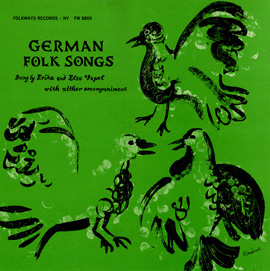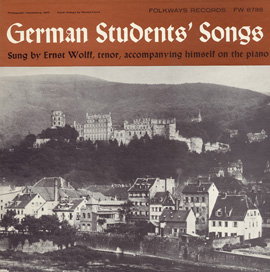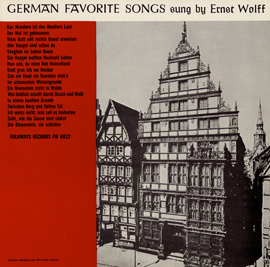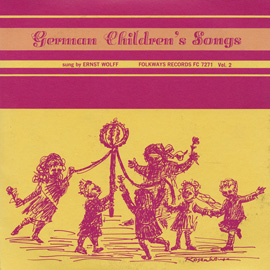Summary
Students are invited to sight-read (solfege), play recorder, listen critically, and create, all in exploration of traditional German children’s songs. They take a further step in comparing these new songs to American children’s songs with which they may be familiar.
Suggested Grade Levels: 3-5
Country: Germany
Region: Europe (Western Europe)
Culture Group: German
Genre: Children’s Folk Songs
Instruments: Voice, Recorder
Language: German (Deutsch)
Co-Curricular Areas: Geography, Social Studies, Language Arts, Art
National Standards: 1, 2, 4, 5, 6, 7, 8, 9
Prerequisites: Students should know how to read rhythms (ta, ti-ti, ta-a), how to sight-read simple melodies using solfege syllables (Do, Re, Mi, Fa, Sol, La, Do’), basic music terminology for describing and analyzing music, and G, A, B, C, and D’ on the recorder.
Objectives:
- Students will read, chant, clap the rhythm of, and sing “Kuckuck” , “A, B, C, Die Katze Lief”, and “In Einem Kleinen Apfel.” (National Standards 1, 5, 9)
- Students will locate and identify Germany on a map and discuss the language, culture, and its people. (National Standard 8)
- Students will listen to examples of German children’s songs and describe the musical characteristics. (National Standard 6)
- Students will play the recorder and hand drum to “Kuckuck”. (National Standard 2).
- Students will create their own lyrics to the melody of a German children’s song. (National Standard !!!!)
- Evaluate music performances and recordings. (National Standard 7)
- Use music terminology/vocabulary and a Venn diagram to compare and contrast German children’s songs from children’s songs familiar to them (American or otherwise.) (National Standards 8, 9)
Material:
- Projector (for maps, images, notation)
- Stereo system (to play recordings)
- “German Children’s Songs, vol. 1” by Ernst Wolff. Tracks 101, 206, and 209 from Smithsonian Folkways FW07270
- World Map: The World HD, by Kengo
- Images: (Teacher can use any search engine by typing in “cuckoo clocks”, “German zither”)
- Musical notation (provided below)
- “Children’s Folk Songs of Germany” Artist Elsa Vopel ; Artist Erika Vopel. Track 101 from Smithsonian Folkways FW07742
- Recorders
- Hand drums
- Paper/Pencil
- Venn diagram handout (attached)
- Crayons
Lesson Segments:
- Introduction to German Children’s Song “Kuckuck” (National Standards 1, 5, 6, 8, 9)
- Musical Exploration and Performance of “Kuckuck” and other German Children’s Songs (National Standards 1, 2, 5, 6, 7, 8, 9)
- Making Comparisons, Drawing Conclusions: German Children’s Songs (National Standards 1, 7, 8, 9)
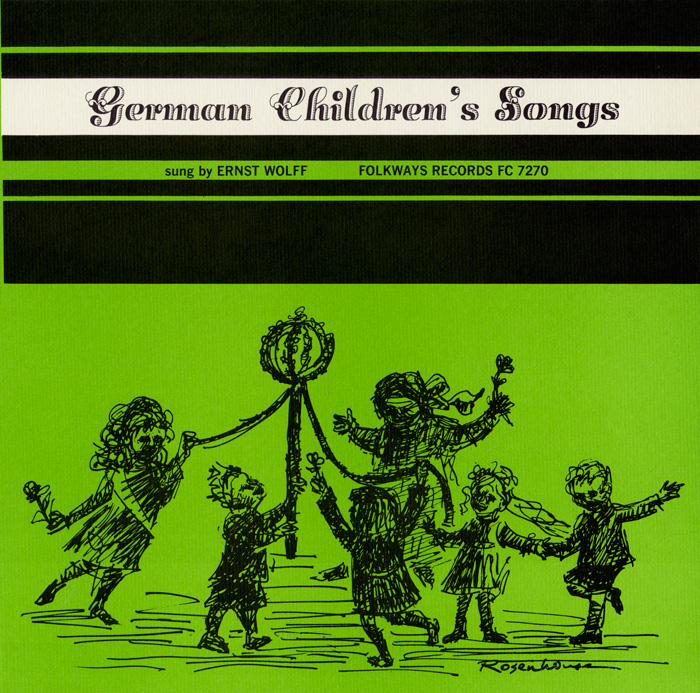
“A,B,C Die Katze Lief”
from German Children's Songs, Vol. 1 (1959) | FW07270
“Kuckuck”
“Alle Vogel Sind Schon Da”
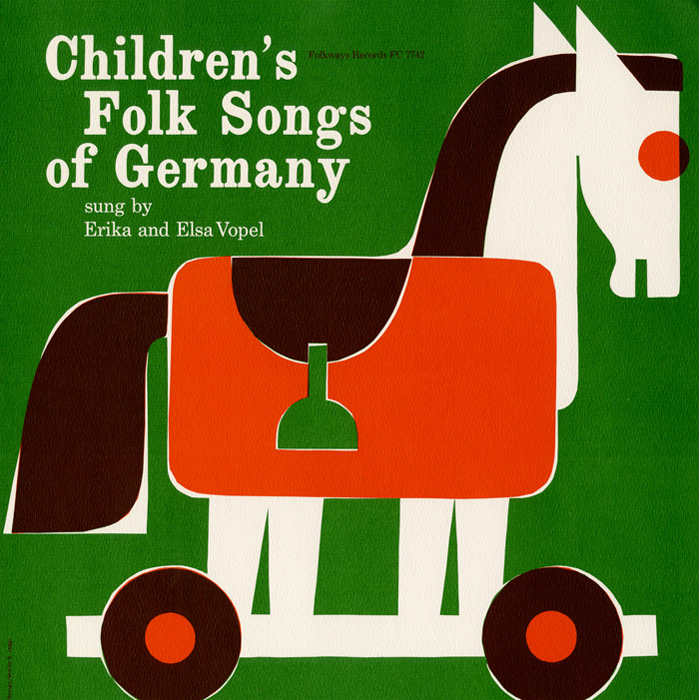
“In Einem Kleinen Apfel”
from Children's Folk Songs of Germany (1960) | FW07742
I. Introduction to German Children’s Songs
1. (Before Listening): Ask students to speak and clap the rhythm of “Kuckuck” using ta’s and ti-ti’s.

- Review solfege syllables and hand signs. Practice reading simple patterns.
- The teacher can notate simple melodic patterns (2 bars) on the board.
- Students sight-read “Kuckuck” using solfege syllables and hand signs.
- Teacher establishes pitch and cues.
- Repeat as necessary.

- Ask the students if they hear any part of the song twice (Measures 1 and 2 are similar to 8 and 9).
- Sing it again, and have the students stand up when they hear the first two measures again (in measures 8 and 9)..
- Teacher asks the students to think about what they hear as they listen to “Kuckuck”
- Play track #206, “Kuckuck”
- Ask the students what they heard (voices [1], instruments? [piano] how many? [1])
- Ask the students if they have heard the melody before (it should sound very familiar!)
- Teacher plays the recording again, asking the students to this about where in the world the song may come from, what language is being sung, and what they think it might be about.
- If the students do not guess that the song is from Germany/sung in German, the teacher should tell them.
- Ask a student to point to Germany a map of the world.
- Also show a map of Europe, and one of Germany.
- (The teacher may use any search engine by typing in “Map of the world/Europe/Germany” for appropriate images, or may use any maps available in the classroom.)
- Provide context and information about Germany:
- Germany is a populous country in Western Europe, bounded to the east by The Czech Republic, and Poland, the west by France, Belgium, and The Netherlands, the south by Switzerland and Austria, and the north by Denmark. People speak German, and many (approximately 80-90%) learn English in school.
- Ask the students what they know about the country. (For example, what climate does it have, what kids of foods do they eat, what they wear or wore in the past, etc.)
- Ask the students what they think the song may be about.
- Germany experiences four seasons, but because several places have high elevation (mountains) and because of its fairly high latitude, Germany often experiences cold, harsh, snowy winters. Therefore, a lot of German folk songs are about the beauty of spring and new life. (See the liner notes for translations.)
- “Kuckuck” is German onomatopoeia for an owl, or may also be used to imitate the sound of a cuckoo clock.
- The teacher may like to show photographs of cuckoo clocks and explain that Germany is famous for producing some of the most intricate, wooden cuckoo clocks in the world(particularly from the Black Forest region).
- Play “Kuckuck” again and ask the students to sing the melody softly on a neutral syllable, such as “loo”.
- Introduce the language:
- Speak the text of each line of “Kuckuck” and have the students repeat:
- Kuckuck, kuckuck
- ruft in dem Wald!
- Lasset uns singen,
- tanzen, und springen!
- Frühling, Frühling,
- wird es nun bald!
- Listen to the recording again, following along with the words.
- Sing with the recording (with the text).
- Sing “Kuckuck” without the recording.

- Discuss the role of children’s songs in societies around the world. (For example: games, lullabies, learning songs, etc.)
- (See Assessment)
- Listen to “In Einem Kleinen Apfel”
- Ask the students to listen for who is performing. Are there instruments?
- As the music is playing, ask the students to show you what instrument they hear by pretending to play.
- Discuss what the students heard:
- Voices (females)
- Plucked string instrument (zither)
- Show photo
- Listen to the recording again, asking the students to tap a steady beat somewhere on their body or desk. Ask the students to listen carefully to the words, and to see if they can figure out what the song is about.
- (Apfel = apple)
Extension (Optional):
- In step ‘a’ of the procedure written above, the teacher may choose to address staccato. An example of how one might approach this is:
- Teacher: “Let’s try that again! This time, I would like you to make the first four ‘ta’s’ short! Can we try just the first two measures together?”
- Practice speaking and clapping the first four quarter notes staccato.
- Teacher: “Who can tell me what it it is called when notes are short like what we just did?”
- Student answers/teacher tells the students: STACCATO!
- Review staccato if necessary.
- In section ‘d’ of the procedure above, they teacher can also introduce or review (whichever is appropriate) sequences with measures 5-8 of “Kuckuck”.
Assessment:
- Students will be divided into small groups to discuss the role of children’s songs in a society. Discussion questions may include:
- Why do we sing children’s songs in America?
- What purpose do they serve? (What do they teach us?)
- Do you think all cultures have songs for children? Why or why not?
- What musical characteristics would you expect a children’s song to have?
- This lesson also provides the teacher with an opportunity to asses the students’ musical progress and abilities:
- Keeping a steady beat (Visual, Aural)
- Reading and clapping rhythms (Visual, Aural)
- Reading simple melodies with solfege and hand signs (Visual, Aural)
- Pitch matching (Aural)
- Describing music using grade-appropriate vocabulary (Oral)
II. Musical Exploration and Performance of “Kuckuck” and other German Children’s Songs
- Play “Kuckuck” and ask students to sing along if they remember.
- (Have the text posted on the board or projector)
- Sing once with the recording and once without.
- Review notes G, A, B, C, and D’ on the recorder (if necessary)
- Students echo the teacher
- Play each phrase of “Kuckuck”
- (Have notation visible if desired)

- Play through the melody of “Kuckuck” on the recorder until the majority of the students feel comfortable.
- Ask two students to play steady quarter notes on a hand drum.
- The students playing recorder should listen for the drum on the rests.
- Listen to “In Einem Kleinen Apfel”
- Ask the students to identify the instrument they hear.
- Have them find a way to show the steady beat on their bodies as they listen.
- Listen again and hum the melody.
- Sing again with the words. (Optional)
- Review the text and translation of “In Einem Kleinen Apfel” (available in the liner notes).
- Divide students into groups and have them create their own lyrics to the melody of “In Einem Kleinen Apfel” (See Assessment).
- Listen to “A, B, C, Die Katze Lief”
- Ask the students:
- What do you hear?
- Can your recognize any words?
- The students should hear A, B, C and recognize that it is part of the alphabet.
- Teach the German alphabet
- A = Ah
- B = Bay
- C = Tsay
- D = Day
- E = Ay (as in “day”)
- F = Ehf
- G = Gay
- H = Hah
- I = Ee
- J = Yot (like “joke”)
- K = Kah
- L = Ehl
- M = Ehm
- N = Ehn
- O = Oh
- P = Pay
- Q = Koo
- R = Air
- S = Ehs
- T = Tay
- U = Oo
- V = Vow (as in “vowel”)
- W = Vay
- X = Iks
- Y = Ipsilon
- Z = Tset
- Listen again and sing along with “A, B, C”
- Listen again
- Ask the students what they hear at the end (text).
- Explain that it is a nonsense word.
- Have the students stand up and walk around the room to the steady beat as they listen again.
- Teach the song:

- Sing with the recording and then without.
Extension (Optional):
- The teacher could introduce the recorder as a German instrument and discuss the different sizes, how they are made, and what role they play in German music, highlighing consorts and it’s role as a solo instrument.
- Dotted rhythms: “A, B, C, Die Katze Lief” has several examples of a dotted-eigth, sixteenth pattern that can be explained and taught.
Assessment:
- Divide the students into small groups. Their assignment is to write their own lyrics to the melody of “In Einem Kleinen Apfel” . The teacher can create his or her own rubric. Grading can be based on effort and participation, or may include elements such as rhyming and matching the syllables to the rhythm.
- Pitch matching (Aural)
- Playing G, A, B, C, and D’ with the correct fingerings on the recorder. (Visual, Aural, Oral)
- Keep a steady beat (Aural, Visual)
III. Making Comparisons, Drawing Conclusions: German Children’s Songs
- Play “In Einem Kleinen Apfel” as the students enter the room.
- Sing the song with the German text as needed with the recording, then without.
- (Student “Presentations”) Invite each group from Lesson Segment 2
- Discussion: German children’s songs:
- Were our performances exactly the same?
- Did we do our best with what we had?
- Were our versions still authentic? (Yes!)
- Assign each student a partner and have them compare and contrast the German children’s songs that they learned to children’s songs that are familiar to them (American or otherwise). (An example of the handout is attached at the end).
- Play “Alle Vögel Sind Schon Da”
- Ask the students if they recognize the second phrase from an American children’s song. (Twinkle, Twinkle).
- Have the students draw a picture of something they learned about German children’s music or Germany. (i.e. something from the Unit). Play the albums in the background as they work.
Extension (Optional):
- Additional songs are available on the albums provided under materials.
- Introduce German wind ensembles and brass bands.
- Use the students’ drawings to create a book about German children’s songs.
Assessment:
Students’ understanding of the material is assessed through discussion participation, worksheet answers, singing, and playing instruments.
- The teacher can assess the students’ performances of their versions of “In Einem Kleinen Apfel”
- Pitch Matching (Aural)
- Rhythm (Aural)
- Effort
- Participation
- Etc.
- Evaluate music performances and recordings. (Oral)
- Venn Diagram (Visual/Oral)
- Drawings (Visual)
Work with your partner to compare and contrast German children’s music from what you know. What characteristics are the same? What are different? What do they have in common?












